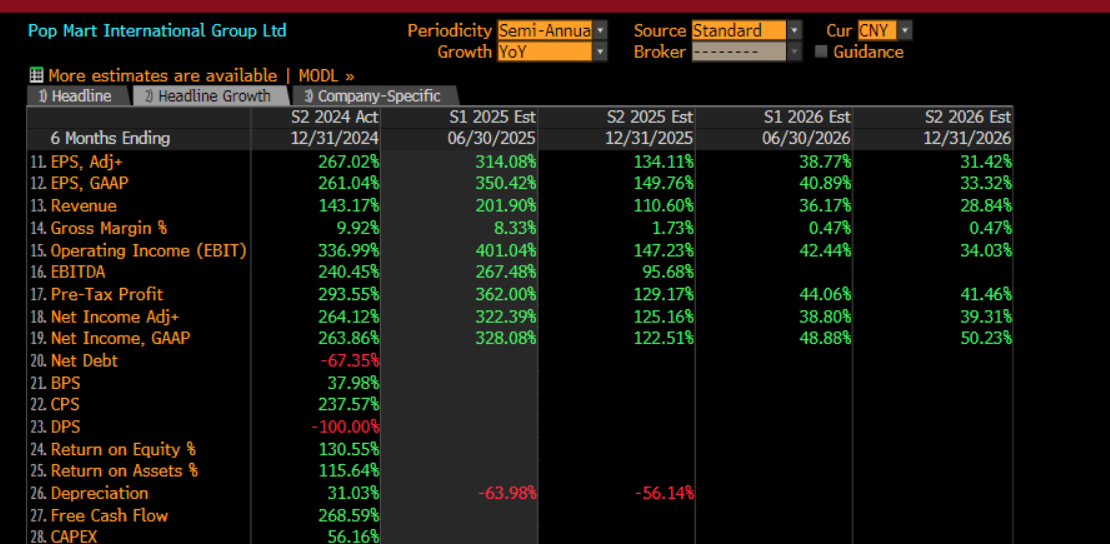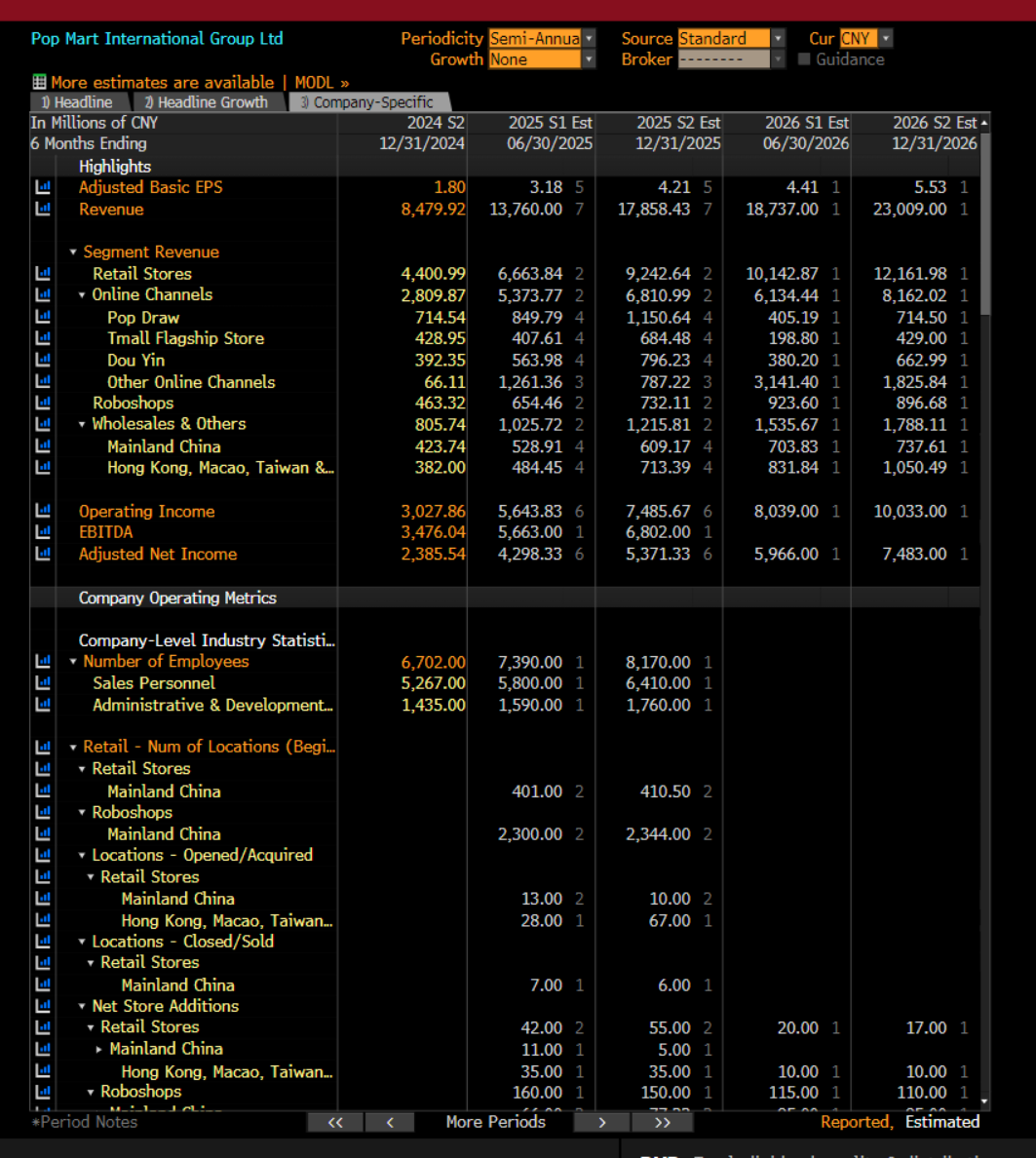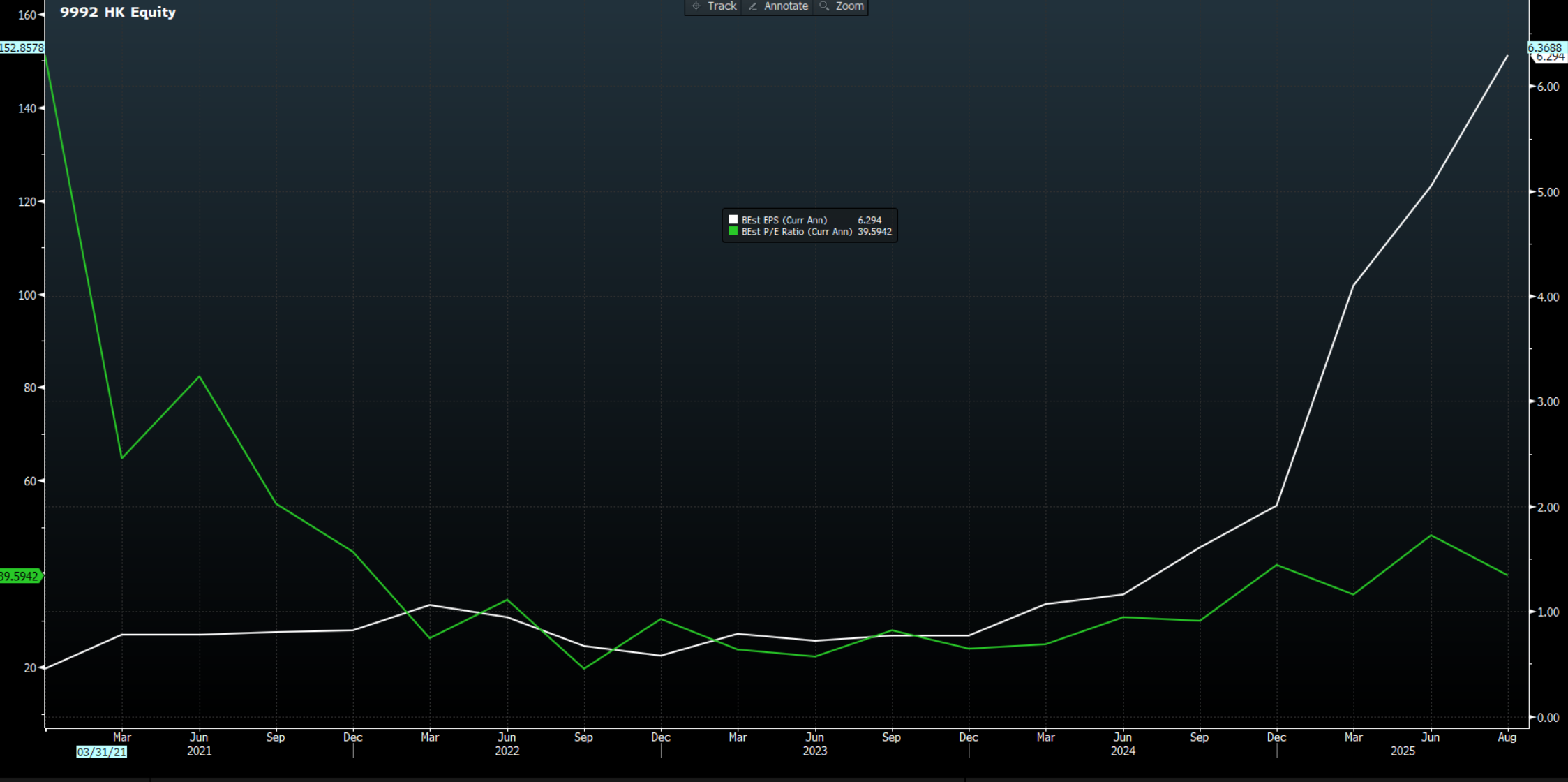CFDs are complex instruments and come with a high risk of losing money rapidly due to leverage. 80% of retail investor accounts lose money when trading CFDs with this provider. You should consider whether you understand how CFDs work and whether you can afford to take the high risk of losing your money.
- English
- 简体中文
- 繁体中文
- ไทย
- Tiếng Việt
- Español
- Português
- لغة عربية
Pop Mart FY25 H1 Earnings Preview: Can Labubu’s Hype Sustain Long-Term Growth?
.jpg)
According to its July earnings forecast, net profit for the first half is expected to rise more than 350% YoY, with revenue up over 200%—marking the strongest performance since listing. Market expectations are broadly aligned with company guidance, with consensus estimates as follows:
- Revenue up more than 200% YoY to ~RMB 13.76 billion;
- Adjusted EPS up over 300% to RMB 3.178;
- Adjusted net profit up more than 320% to ~RMB 4.3 billion.

Given such optimism, the stock has shown strong momentum. After pulling back from its August peak of 293.4, it is now retesting the upper bound of its consolidation range at 284. This earnings release will be a key inflection point for assessing the alignment between market expectations and actual results.

A Hype-Driven Profit Engine
Pop Mart has transformed from a niche collectible brand in China into a global cultural phenomenon. Through IPs such as Labubu, it has reshaped young consumers’ habits and cultural identity. At the core is its high-margin, IP-driven model and scalable global expansion strategy, which set it apart in the consumer sector.
In Q1 2025, revenue surged around 170% YoY, with international revenue soaring nearly 480%, while plush toy sales skyrocketed over 1,200%. This reflects not only Labubu’s blockbuster effect, but also the early success of the company’s IP portfolio and overseas expansion. With new stores opening in Paris, Melbourne, and New York’s Times Square, overseas revenue contribution is approaching that of domestic operations - and may soon overtake it.
As of end-2024, Pop Mart operated 130 overseas stores (including JVs), generating nearly RMB 3.1 billion in revenue, with average per-store sales nearly triple that of domestic outlets. In 2025, the company plans to add 100 more overseas stores, around 30% of which have already launched, primarily in North America and Southeast Asia.

This suggests H1 results may show further gains from international operations, though investors will be watching store ramp-up pace, unit economics, and whether premium pricing can sustain margins.
Valuation and Risk Considerations
Despite the bullish EPS outlook compressing Pop Mart’s P/E ratio, the stock still trades around 40x earnings - near its historical midpoint. To justify this valuation, profits would need to compound at 40–50% annually over the next 3–5 years, requiring consistently strong execution.

Risks remain concentrated in IP reliance. Labubu is the current star, but other IPs like Molly, Skullpanda, and Crybaby are still in early stages. Whether Labubu’s popularity can be sustained, and whether the company can successfully incubate the next hit IP, will be decisive for long-term growth.
Should H1 results disappoint, the stock could face volatility or a short-term pullback. Conversely, stronger-than-expected overseas contribution and IP diversification could trigger another leg higher.
Expanding IP Commercialization Beyond Blind Boxes
To reduce reliance on its traditional “blind box” revenue stream, Pop Mart is aggressively expanding IP commercialization through licensing, derivatives, and cross-industry collaborations. Following partnerships with Coca-Cola, Lay’s, and L’Oréal, the “Uniqlo x Labubu UT Collection” will debut on August 22 in mainland China and Hong Kong.
This licensing deal not only broadens Labubu’s commercialization path but also enhances earnings visibility and flexibility. A strong launch could lift both profit expectations and valuation.
Pop Mart has also been active in content and offline experiences. From the debut of the “Labubu & Friends” animation and the launch of themed jewelry stores to a steady stream of new products, the company is broadening IP applications, strengthening fan engagement, and laying the groundwork for future global entertainment potential and repeat purchases.
Focus on Global Reach and a Stronger IP Matrix
In summary, Pop Mart’s H1 earnings matter to traders and investors on three fronts:
- Whether Labubu’s sales and contribution exceed expectations;
- The share and profitability of overseas revenue;
- The potential of new IPs or product lines to drive future growth.
Post-earnings, market focus will be on the gap between expectations and delivery. In the short term, the stock may consolidate as it digests results. Over the long run, Pop Mart is transitioning from a niche collectible brand to a global, multi-IP cultural consumption platform, with significant growth potential ahead.
From a trading strategy perspective: if Labubu sales or overseas revenue fall short, investors could look for pullback opportunities or hedging strategies; if results exceed expectations, particularly in overseas markets, a buy-on-dip approach could be attractive as the stock prices in the next wave of valuation re-rating. Meanwhile, risks such as Chinese regulatory scrutiny, controversies around blind box sales, and potential IP fatigue must be closely monitored.
The material provided here has not been prepared in accordance with legal requirements designed to promote the independence of investment research and as such is considered to be a marketing communication. Whilst it is not subject to any prohibition on dealing ahead of the dissemination of investment research we will not seek to take any advantage before providing it to our clients.
Pepperstone doesn’t represent that the material provided here is accurate, current or complete, and therefore shouldn’t be relied upon as such. The information, whether from a third party or not, isn’t to be considered as a recommendation; or an offer to buy or sell; or the solicitation of an offer to buy or sell any security, financial product or instrument; or to participate in any particular trading strategy. It does not take into account readers’ financial situation or investment objectives. We advise any readers of this content to seek their own advice. Without the approval of Pepperstone, reproduction or redistribution of this information isn’t permitted.